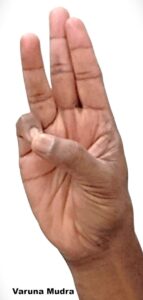Varuna Mudra
Introduction
Varuna Mudra is a yogic hand gesture aimed at balancing the water element (Jala) in the body according to Ayurveda. This mudra is effective in maintaining hydration, improving fluid balance, and enhancing skin and tissue health. It also supports mental clarity and emotional stability, as the water element influences emotional flow and calmness.
The term Varuna in Sanskrit refers to the god of water, symbolizing fluidity, balance, and purification. This mudra is often used in yoga therapy, meditation, and pranayama for overall health and energetic balance.
Meaning
Varuna: Water element; associated with fluidity, balance, and purification.
Mudra: Gesture used to influence pranic flow and physiological processes.
Overall Meaning:
Varuna Mudra enhances hydration, fluid circulation, and balance of emotional and physical water elements in the body.
How to Perform / Practice
Sit comfortably in a meditative posture (Padmasana, Sukhasana, or on a chair) with an erect spine.
Place your hands on your lap or thighs, palms facing upward.
Join the tip of the little finger with the tip of the thumb.
Keep the other three fingers extended comfortably.
Close your eyes, breathe slowly and deeply, and focus on fluidity, calmness, and energy balance.
Practice for 15–30 minutes daily, or in shorter intervals of 5–10 minutes.
Tip: Can be practiced anytime during the day, particularly when experiencing dryness, dehydration, or emotional imbalance.
Benefits
Physical Benefits:
Maintains hydration and fluid balance in the body.
Improves skin health, moisture, and tissue elasticity.
Supports joint lubrication and metabolic processes.
Mental & Emotional Benefits:
Calms the mind and reduces restlessness, irritability, and emotional turbulence.
Enhances mental clarity, focus, and emotional stability.
Supports relaxation and stress reduction.
Energetic / Spiritual Benefits:
Balances Jala (water) element in the body and pranic channels.
Promotes smooth flow of energy and emotions.
Enhances meditation by fostering a sense of fluidity, adaptability, and calmness.
Contraindications
Avoid if experiencing hand or finger injuries.
Not recommended for severe arthritis or joint pain in fingers.
Discontinue if numbness, tingling, or discomfort occurs.
Practice moderately in cases of excess Kapha, as it may increase fluid retention.
Anatomy & Physiology
Muscles: Engages intrinsic hand muscles (lumbricals, interossei) to maintain tip-to-tip contact.
Joints: Flexion at thumb and little finger; extension at other fingers.
Nervous System: Activates parasympathetic pathways, promoting relaxation and calmness.
Circulation: Improves microcirculation in hands and indirectly influences systemic fluid regulation and metabolic balance.
Kinesiology
Enhances fine motor coordination of fingers.
Supports static postural stability while seated in meditation.
Encourages relaxed hand posture, aiding focus and energy balance.
Neurology
Stimulates brain regions associated with emotional regulation and calmness.
Balances sympathetic and parasympathetic activity, reducing stress and enhancing mental clarity.
Supports neural plasticity in areas related to attention, emotional stability, and meditation.
Duration of Practice
Daily Practice: 15–30 minutes, can be split into 2–3 sessions.
Short Practice: 5–10 minutes during meditation, relaxation, or work breaks.
Can be combined with Prana Mudra or Surya Mudra for enhanced energetic and metabolic benefits.
Counter Mudra
If excess fluid accumulation or sluggishness occurs, switch to Prithvi Mudra or Surya Mudra to balance energy.
Gentle hand stretching or shaking is recommended after prolonged practice.
Conclusion
Varuna Mudra is a powerful hand gesture to balance the water element, maintain hydration, and stabilize emotions. Regular practice supports physical, mental, and energetic well-being, making it ideal for yoga, meditation, and daily health maintenance. Proper execution ensures maximum benefits without discomfort.
FAQ
Q1: Can beginners practice Varuna Mudra?
A: Yes, it is safe and simple; start with 5–10 minutes and gradually increase.
Q2: Can it improve skin and hydration?
A: Yes, it supports fluid balance and tissue health.
Q3: Can it be combined with other mudras?
A: Yes, it can be combined with Prana Mudra or Vajra Mudra for enhanced energy and vitality.
Q4: Is it suitable for meditation?
A: Yes, it enhances mental calm, emotional stability, and mindfulness.
References
Swami Satyananda Saraswati, Mudras for Healing and Transformation.
Iyengar, B.K.S., Light on Yoga.
Saraswati, S., Pranayama and Mudras in Yoga Therapy.
Fishman, L., Yoga for Emotional Balance.
Lad, V., Ayurveda: The Science of Self-Healing.
Journal of Bodywork and Movement Therapies, 2018; 22(4): Effects of Hand Mudras on Mental and Physiological Functions.

